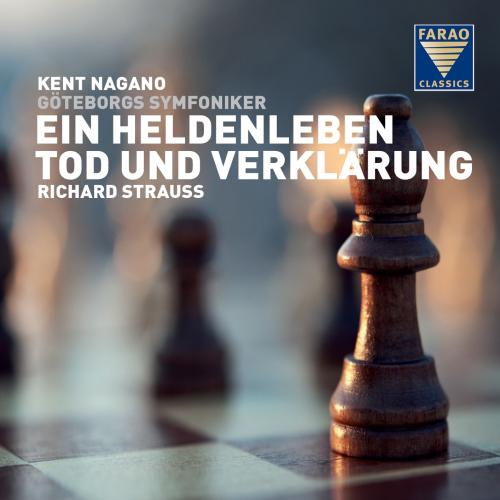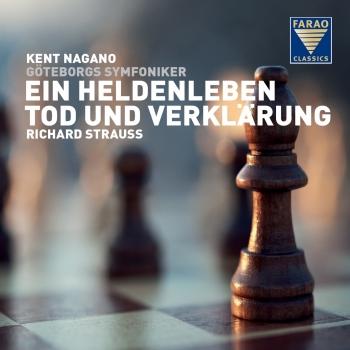
Strauss: Ein Heldenleben Tod & Verklärung Göteborg Symfoniker & Kent Nagano
Album info
Album-Release:
2017
HRA-Release:
20.10.2017
Label: Farao Classics
Genre: Classical
Subgenre: Orchestral
Artist: Göteborg Symfoniker & Kent Nagano
Composer: Richard Strauss (1864-1949)
Album including Album cover Booklet (PDF)
- Richard Strauss (1864 - 1949): Ein Heldenleben, op. 40:
- 1 Ein Heldenleben, op. 40 - Der Held 04:12
- 2 Ein Heldenleben, op. 40 - Des Helden Widersacher 03:13
- 3 Ein Heldenleben, op. 40 - Des Helden Gefährtin 07:05
- 4 Ein Heldenleben, op. 40 - Mäßig langsam 05:46
- 5 Ein Heldenleben, op. 40 - Des Helden Walstatt 01:37
- 6 Ein Heldenleben, op. 40 - Festes Zeitmaß (sehr lebhaft) 05:46
- 7 Ein Heldenleben, op. 40 - Mit großem Schwung und Begeisterung 02:20
- 8 Ein Heldenleben, op. 40 - Des Helden Friedenswerke 07:54
- 9 Ein Heldenleben, op. 40 - Des Helden Weltflucht und Vollendung 02:12
- 10 Ein Heldenleben, op. 40 - Langsam 04:38
- Tod und Verklärung, op. 24:
- 11 Tod und Verklärung, op. 24 - Largo 05:07
- 12 Tod und Verklärung, op. 24 - Allegro, molto agitato 03:56
- 13 Tod und Verklärung, op. 24 - Meno mosso, ma sempre alla breve 05:08
- 14 Tod und Verklärung, op. 24 - A tempo primo 03:47
- 15 Tod und Verklärung, op. 24 - Moderato 07:50
Info for Strauss: Ein Heldenleben Tod & Verklärung
The second recording of the Strauss trilogy with Sweden’s national orchestra under the baton of its Principal Guest Conductor Kent Nagano.
As the long-time General Music Director of the Bavarian State Opera, Kent Nagano possesses a deep understanding of the music of Richard Strauss, the Munich Strauss tradition, and authentic sources stemming from the Strauss family.
What is less well known is that the Gothenburg Symphony Orchestra can also lay claim to an impressive Strauss tradition. As early as its very first concert season in 1905/06, the orchestra performed Don Juan. Death and Transfiguration, conducted by Wilhelm Stenhammar, was added to the repertoire in 1912, and Ein Heldenleben formed part of the orchestra’s programs in the 1970s.
In this new production of one of the most often-recorded orchestral works, Kent Nagano has chosen what is for him a characteristic approach: The life path of the hero Richard Strauss is not presented in a superficial and obvious way, reduced to purely illustrative program music that owes its effects to the overwhel- ming power of an enormous orchestral apparatus. Instead, Nagano and the Gothenburg Symphony Orchestra seek out the nuances, the compositional and tonal details – and reveal the brokenness experienced by the hero, the inner emotions, perceptions, and self-doubt found beneath the surface of the score, which often tends to be interpreted one-dimensionally.
The great violin solo that is a portrayal of Strauss’s wife Pauline is usually performed by the (mostly male) first concertmasters of the major orchestras. But here Sara Trobäck, First Concertmaster of the Gothenburg Symphony Orchestra, offers an unexpectedly different, feminine view of “The Hero’s Companion.”
When we hear the final phase of the life path traversed by Strauss’s “hero,” Nagano’s interpretation reveals to us not only the idealized late Romantic idiom in which the 34-year-old composer cast his two main characters. We also discover in the score the brokenness of the elder Strauss when, after the end of the Third Reich and having passed his eightieth year, he experienced his own catharsis and transfiguration.
It thus ties in perfectly with the tone poem Death and Transfiguration, in which Richard Strauss and Kent Nagano tell us a very similar human story.
The third part of the Strauss cycle will feature Till Eulenspiegel’s Merry Pranks and the Symphonia Domestica and is planned for release in autumn 2018.
Gothenburg Symphony Orchestra
Kent Nagano, conductor
No biography found.
Booklet for Strauss: Ein Heldenleben Tod & Verklärung










